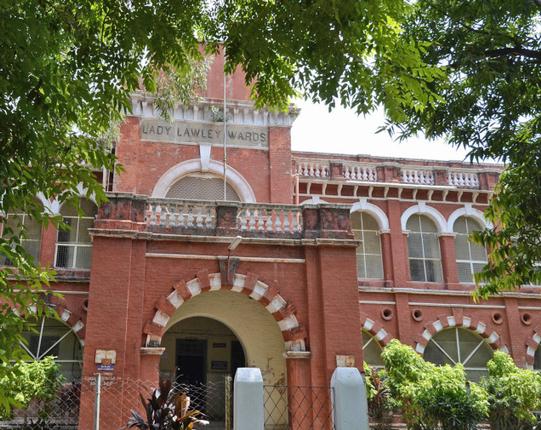Government Ophthalmic Hospital / Photo: R. Shivaji Rao / The Hindu
ANUSHA PARTHASARATHY scans through the records of the Regional Institute of Opthamology and Government Ophthalmic Hospital, the second oldest eye hospital in the world
he sheltered verandahs and roofed passages that connect an entire campus of red-brick buildings echo the story behind the second oldest eye hospital in the world. Started in 1819, many pieces of the Regional Institute of Opthamology and Government Ophthalmic Hospital’s history lie in the arched corridors of Elliot’s Museum and a black plaque outside its Egmore premises; ‘Government Infirmary for gratuitous treatment of diseases of the eye’.
A board in the garden at the entrance of the hospital clearly mentions the year of founding, second only to Moorfields Eye Hospital in London (established in 1818). On the other side of the road, in the newer campus is director Dr. K. Vasantha’s office. A long wooden board with a list of the names of the hospital’s directors and superintendents hangs on the wall next to her chair.
Dr. Travers, a surgeon in London with the East India Company, was one of the reasons for the setting up of the Madras Eye Infirmary. And Dr. Robert Richardson, another surgeon, came to Madras to establish it in July 1819. It began in Royapettah, on the grounds where the Wesley Church now stands. “It was later somewhere near the Dina Thanthi office, after which it was shifted here,” says Dr. Vasantha. It was a tram shed that it occupied in Egmore from 1820 onwards. The infirmary came to its present location in 1884. In 1888, the infirmary came to be the Government Ophthalmic Hospital.
Lieutenant Colonel R.H. Elliot, who was the superintendent between 1904 and 1913 is a rather popular figure even today. He is credited for the ‘Elliot’s Trephine’, an instrument used in glaucoma surgery. The hospital too was expanded during his tenure, with the Lawley Ward coming into place at its centre. “The hospital started with a couple of buildings and now we have a department for everything related to the eye. The Lawley Ward has been declared a Heritage Building by the Archaeological Department of India,” she says.
Lieutenant Colonel Kirkpatric succeeded Elliot and a school was opened inside the premises in 1919. This block was then called ‘Elliot’s School of Ophthamology’. The ‘Museum of Elliot’ was conceived and opened by Kirkpatric’s successor, Lieutenant Colonel R.E. Wright and has manuscripts dating back to 1819. There are specimens, different models of diseases of the eye and sketches of tropical eye diseases by earlier doctors. These sketches were drawn by a professional artist in a time when cameras were unknown, to document the various symptoms and effects.
“Doctors at this hospital were performing all the surgeries we do today even in those days but only their methods were different,” says Dr. Vasantha, “What has changed is that our incisions are smaller and methods have advanced with better technology.”
The first Indian superintendent, Dr. K. Koman Nayar, assumed charge in 1940. In 1942, the school started offering a Post Graduate Diploma in Ophthamology. Koman Nayar is also remembered for the Iris Repositor that he built.
Dr. R.E.S. Muthayya, the next superintendent, opened the first ‘Eye Bank’ within the premises in 1948. “We now have an entire block that’s just the eye bank,” says Dr. Vasantha. “And the last 30 years has seen a partnership between the Lion’s Club and our hospital, with reference to the eye bank. They maintain the vans which we take around to collect eyes. Dr. Muthayya was also the first to perform a keratoplasty but for some reason, this went unrecorded.”
In 1960, the premises opposite the old campus were acquired for expansion. “It was a garden house which was used as the nurses’ quarter,” Dr. Vasantha explains. In 1962, the School of Optometry was started inside this campus.
The next in line was Dr. E.T. Selvam, who bought the hospital’s first microscope. “We now use these microscopes for all surgeries,” she adds. In 1985, the hospital became a Regional Institute under the National Programme for Control of Blindness. “It was recognised by the Central Government as a centre of excellence. Government Ophthalmologists from all over the country are sent here for training.”
The maze-like passages in the old campus lead to the grand old staircase of the Elliot Building. Beside it is a room from which muffled voices escape through the gaps in the doors. Open them, and the school’s old classroom is still in use but with hand-held microphones and air conditioners. “We’re trying to make sure even the older parts of the building are still in use so that they are maintained and continue to be a part of this hospital,” says a doctor on duty.
source: http://www.TheHindu.com / Home> Arts> History / by Anusha Parthasarathy / October 16th, 2012
